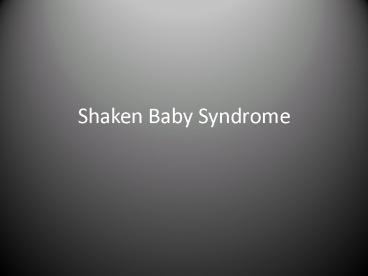Shaken Baby Syndrome - PowerPoint PPT Presentation
1 / 18
Title:
Shaken Baby Syndrome
Description:
Shaken Baby Syndrome Shaken baby syndrome is Shaken Baby Syndrome- Is a form of child abuse that is thought to occur when an abuser violently shakes an infant or ... – PowerPoint PPT presentation
Number of Views:610
Avg rating:3.0/5.0
Title: Shaken Baby Syndrome
1
Shaken Baby Syndrome
2
Shaken baby syndrome is
- Shaken Baby Syndrome- Is a form of child abuse
that is thought to occur when an abuser violently
shakes an infant or small child, creating a
whiplash-type motion that causes
acceleration-deceleration injuries. - A serious brain injury
- Occurs when a baby is slammed against a hard
object
3
- Shaking is usually done out of frustration or
anger - Shaking must be of such force that an independent
observer would recognize the act as dangerous - A babies brain and the blood vessels connecting
the skull to the brain are fragile and immature - When a baby is shaken, the brain ricochets about
their skull, causing the blood vessels to tear
away and blood to pool inside their skull causing
irreparable damage to the brain
4
- SBS also called shaken impact syndrome and
non-accidental head injury. - Can occur in children up to five years old, but
in most cases the child is under one years old. - SBS, is a major cause of mortality in infants, is
often fatal and can produce lifelong disability
from neurological damage. - Leading cause of injury in children under four
years of age
5
- 50 of deaths related to child abuse are related
to SBS. - About 25 to 30 of infant victims with SBS die
from their injuries.
6
Child Risk Factors
- Small children are especially vulnerable to this
type of abuse. Their heads are larger in
comparison to their bodies. - Children under one years of age are at the
highest risk. - Children who are sick, teething, or toilet
training - Children who already have disabilities
7
Parental Risk Factors
- Young parental age
- Unstable family environment
- Low socioeconomic status
- Unrealistic child-rearing expectations
- Rigid attitudes and impulsivity
- Feelings of inadequacy, isolation, or depression
- Negative childhood experiences including neglect
or abuse
8
Some Statistics
- One shaken baby in four dies
- Some studies estimate that 15 of childrens
deaths are due to battering or shaking, and an
additional 15 are possible cases of shaking. - Of the 37 children that died in Florida in
1995-96 13 died from a combination of SBS/Head
Trauma
9
- Of the thousands that survive death, serious
injury usually occurs. - More than 60 of the victims of SBS are male
- Almost 80 of the perpetrators of SBS are male,
usually the biological father or boyfriend to the
mother
10
Whos Watching The Baby
- 50 of Offenders are Natural Parents
- 17 are non- relatives
- 17 are mothers boyfriend
- 6 are step parents
- 10 are other
11
Signs and symptoms
- Head turned to one side
- Unable to lift or turn head
- Pinpointed, dilated, or unequal pupil size
- Blood pooling in eyes
- Pupils unresponsive to light
- Bulging or spongy forehead
- No smiling or vocalization
12
- Poor sucking or swallowing
- Rigidity
- Semi-consciousness, lethargy, or decreased muscle
tone - Difficulty breathing
- Seizures and spasms
- Swollen head, which may appear later
- Poor feeding or eating
13
- Cardiopulmonary arrest
- Vomiting
- Failure to thrive
- Pale or bluish skin
- Irritability
- Coma
14
Diagnosis
- The basis for the diagnosis of inflicted injury
is a physical exam that conflicts with the
explanation from parents as to what happened - The following should alert health care providers
to the possibility of SBS - Any infant or child who presents with a history
that is not plausible or consistent
15
- The presence of a new adult partner in the home
- A history of delay in seeking medical attention
- A previous history or suspicion of abuse
- The absence of a primary caretaker at the onset
of injury or illness - Physical evidence of multiple injuries at varying
stages of healing - Unexplained changes in neurologic status
16
Prognosis
- Retinal hemorrhages
- Petechiae on the body or face
- Multiple fractures of the long bones
- Subdural hematomas
- Learning disabilities
- Seizure disorders
- Speech disability
- Hyrocephalus
17
- Behavioral problems
- Cerebral palsy
- Visual disorders
- DEATH
18
Prevention
- The only way to avoid SBS is to use common sense
and keep a close eye on your child for the first
two years of life - Meet basic needs of baby
- Feed
- Burp
- Change
- Clothing not to tight
- Not to hot or cold
- ASK FOR HELP































